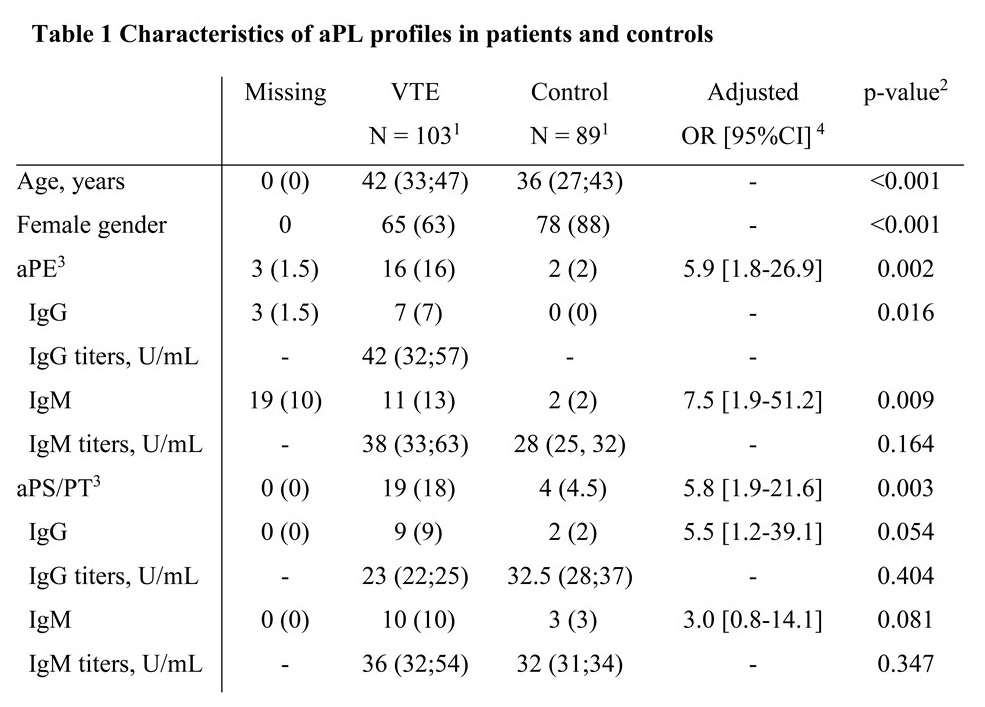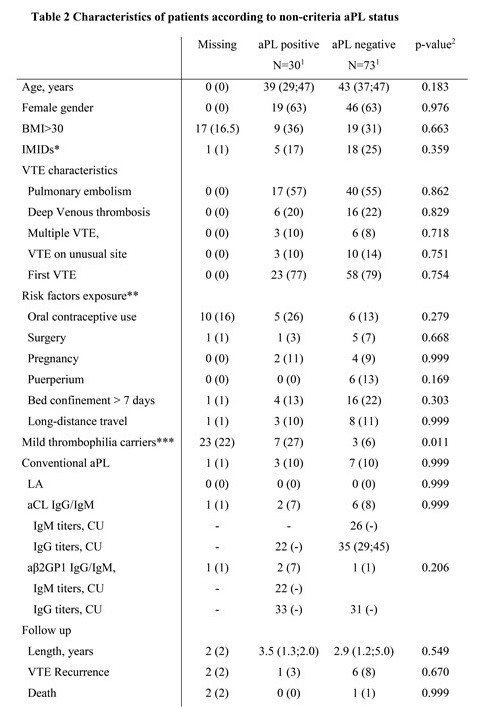Session Information
Session Type: Poster Session A
Session Time: 10:30AM-12:30PM
Background/Purpose: Antiphospholipid syndrome (APS) is an autoimmune disease characterized by the occurrence of thromboses and/or pregnancy morbidity in the presence of persistent antiphospholipid autoantibodies (aPL) namely, lupus anticoagulant (LA), IgG/IgM anticardiolipin (aCL) and/or IgG/IgM anti-β2glycoprotein-1 (aβ2GPI) antibodies. We aimed to determine the frequency of non-criteria aPL autoantibodies in patients younger than 50 years old admitted for venous thromboembolism (VTE).
Methods: Patients younger than 50 years old admitted for VTE in the departments of Internal Medicine from 2 tertiary care centers in France were screened. Patients with active cancer, congenital or acquired thrombophilia, and catheter– or extrinsic venous compression-induced VTE were excluded. Testing for non-criteria aPL autoantibodies included anti-phosphatidylethanolamine (aPE) IgG/IgM and anti-phosphatidylserine/prothrombin (aPS/PT) IgG/IgM. Patients were screened in the setting of care for antithrombin, protein C and protein S deficiencies, prothrombin gene and factor V Leiden mutations and conventional antiphospholipid antibodies (i.e. LA, aCL aβ2GPI autoantibodies). Testing for non-criteria aPL autoantibodies was also performed in a control group of patients < 50 without history of thrombosis. All clinical characteristics were extracted from electronic medical records.
Results: Over the considered period, 173 patients younger than 50 admitted for VTE were screened. Among them, 70 (n=70/173, 40.4%) were excluded because of congenital thrombophilia (protein S deficiency, n=7; protein C deficiency, n=3; antithrombin deficiency, n=2), acquired thrombophilia (APS, n=25; Behçet’s syndrome, n=5; nephrotic syndrome, n=5), active malignancy (n=15), or catheter/extrinsic venous compression-induced VTE (n=8). Overall, 103 patients (63% of women; median age 42 (33;47) years) were studied. VTE was a pulmonary embolism in 57 cases (n=57/103, 55%) and accounted for a first thrombotic episode in 81 patients (n=81/103, 79%). Moderate titers of non-criteria aPL autoantibodies were detected in 30% (n=30/103) of patients with VTE and in 6% (n=5/89; p< 0.001) of controls (n=89, 12% of women; median age 36 (27;43) years) (Table 1). aPL autoantibodies were aPS/PT IgG/IgM in 19 cases (n=19/30; 63%) and aPE IgG/IgM in 16 cases (n=16/30; 53%). Of note, non-criteria aPL autoantibodies in patients VTE were more frequently detected in mild thrombophilia carriers (n=7/26, 27% vs 3/54, 6%, p=0.011). Over a 3(1;5) years follow-up, 7 (n=7/103; 7%) patients experienced a new VTE that occurred 4.3 (3;8.1) years after the first VTE. New VTE happened while oral coagulant have been stopped in all cases for 2.3 (1;6.1) years. Non-criteria aPL autoantibodies were not associated with recurrent VTE (Table 2).
Conclusion: The frequency of non-criteria aPL autoantibodies, mostly aPS/PT, is high in patients younger than 50 years old admitted for VTE but does not seem associated with the risk of recurrent thrombosis.
1. Continuous variables are summarized with median (quartile 1;quartile 3) and categorical variables with n (%).
2. Pearson’s Chi-squared test; Wilcoxon rank sum test; Fisher’s exact test
3. The cutoff was fixed at 20 U/ml for aPE and 30 U/ml for aPS/PT as recommended by the manufacturer.
4. Adjusted odd ratios for age and sex.
*IMIDs, immune-mediated inflammatory diseases including systemic lupus erythematosus (n=9), Graves disease (n=3), inflammatory bowel disease (n=3), Sjogren’s syndrome (n=3), sarcoidosis (n=2), immune thrombocytopenic purpura (n=2), pernicious anemia (n=2), dermatomyositis (n=1),
**within 3 months, n (%)
***heterozygosity for factor V Leiden or G20210A prothrombin mutation
1. Continuous variables are summarized with median (quartile 1;quartile 3) and categorical variables with n (%).
2. Wilcoxon rank sum test; Pearson’s Chi-squared test; Fisher’s exact test; Wilcoxon rank sum exact test
To cite this abstract in AMA style:
DAWUDI Y, Gourmelon C, Mageau A, DUMONT B, HELFER H, ROUZAUD D, Papo T, MAHE I, Roland-Nicaise P, Sacré K. Screening for Non-criteria Antiphospholipid Autoantibodies in Patients Younger Than 50 Years Old Admitted for Venous Thromboembolism: A Cross-sectional Study [abstract]. Arthritis Rheumatol. 2024; 76 (suppl 9). https://acrabstracts.org/abstract/screening-for-non-criteria-antiphospholipid-autoantibodies-in-patients-younger-than-50-years-old-admitted-for-venous-thromboembolism-a-cross-sectional-study/. Accessed .« Back to ACR Convergence 2024
ACR Meeting Abstracts - https://acrabstracts.org/abstract/screening-for-non-criteria-antiphospholipid-autoantibodies-in-patients-younger-than-50-years-old-admitted-for-venous-thromboembolism-a-cross-sectional-study/


